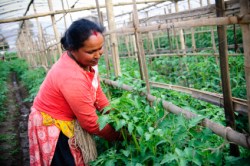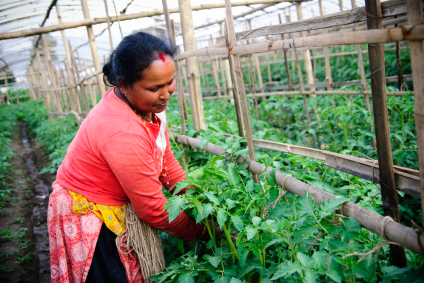 If last week’s Rio+20 Earth Summit made anything clear to those of us at home, it’s the degree to which the world’s developed nations have been sitting on their hands since the original Earth Summit 20 years ago. As Grist’s Greg Hanscom reported from the summit, the “outcome document” was negotiated before the week started, and “the overwhelming feeling [there], even as world leaders and celebrities rolled in for the official pomp and circumstance, was that the summit was over even before it began.”
If last week’s Rio+20 Earth Summit made anything clear to those of us at home, it’s the degree to which the world’s developed nations have been sitting on their hands since the original Earth Summit 20 years ago. As Grist’s Greg Hanscom reported from the summit, the “outcome document” was negotiated before the week started, and “the overwhelming feeling [there], even as world leaders and celebrities rolled in for the official pomp and circumstance, was that the summit was over even before it began.”
Meanwhile, Bill McKibben called the event a “formulaic bureaucracy-fest” wherein the only real excitement was a walkout staged by young activists.
So where was food and agriculture in all this? Food was one of seven “critical issues” identified by the U.N. before Rio+20 began, as population growth (we’ll have another 2 billion people on the planet by 2050) and climate change have put the question of food access into sharp focus. But a quick look at the “issue brief” prepared before the summit will tell you most of what you need to know about the vast chasm that exists between the kinds of goals articulated in meetings like this and the level of real change occurring on the ground. “Global delivery of the food security and sustainable agriculture-related commitments has been disappointing,” the brief reads. And it’s easy to see why; a table reporting on target goals set as early as 1995 is filled with stalled progress, lack of funding, and a general dearth of political will. Here are a few examples:
Target: To develop and maintain in all countries the integrated plant nutrition approach, and to optimize availability of fertilizer and other plant nutrient sources.
Year proposed: 2000
Progress: Not achieved. Several areas are nutrient depleted.Target: National systems for environmentally sound management of chemicals, including legislation and provisions for implementation and enforcement, should be in place in all countries to the extent possible.
Year proposed: 2000
Progress: Some progress made. Limited resources and political will hamper progress.Target: Globally harmonized hazard classification and 2000 compatible labeling system, including material safety data sheets and easily understandable symbols, should be available, if feasible.
Year: 2000
Progress: Harmonized system developed. Uptake is slow.Target: Improve the efficient use of water resources and promote their allocation among competing uses in a way that gives priority to the satisfaction of basic human needs and balances the requirement of preserving or restoring ecosystems and their functions.
Year: 2005
Progress: Not achieved — several areas are running out of water.Target: Halve the proportion of the world’s 2015 people whose income is less than $1 a day and the proportion of people who suffer from hunger.
Year: 2015
Progress: On track to reach poverty but not hunger target.
You get the idea. Every few years, the international community comes together to think big about how agriculture could and should really change. And then they let a few years pass before they meet again to reiterate the same goals.
In Rio last week, food did end up in the final document — in the form of something called a Zero Hunger Challenge — but it appears that to save themselves the embarrassment of missing the mark later down the road, the negotiators kept the targets nice and vague.
The Zero Hunger Challenge comes with a list of five worthwhile goals, including “all food systems are sustainable,” along with food security (or an end to hunger through redistribution), support for small farmers, and the reduction food waste. But, as The Guardian adds, “there is no reference to how [sustainable food systems] could be achieved” and “no deadline has been set for achieving these aims.” The Rio+20 draft outcome document also mentions the need to “address the root causes of excessive food price volatility.”
There was also a whole daylong event in Rio dedicated to food and farming, but it too was full of grand, vague messaging about sustainability. (Ever since companies like Monsanto started using “sustainable agriculture” to describe their work, it has become especially difficult to tell if and when the term has any teeth.) Try reading this Huffington Post blog entry, written by a representative from a food and climate NGO, and you’ll see what I mean.
To feed a global population of 9 billion people by 2050 will require a 60 to 70 percent increase in global food production and a 50 percent rise in investments in food, agriculture, and rural development. Unabated climate change could cost the world at least 5 percent of GDP each year and seriously undermine the ability of small-scale farmers to provide food for their families and national and global markets. We must take heed of the reminder from Dyborn Chibonga, CEO of the National Smallholder Farmers Association of Malawi, that “the hand hoe is an instrument of mass urbanization,” and step forward to develop and disseminate appropriate technologies for meeting gaps in yields, in livelihoods, and in climate resilience.
The “dissemination of appropriate technologies for meeting gaps in yields”? In this context that phrase could refer to something as simple as adding a mule to the farm, or something as complex as introducing a combined program of GMO seeds and the pesticides they’re engineered to be used with.
Especially confusing in this regard is the use of the relatively new term “climate smart agriculture,” which was established at the U.N. conference on climate change in Durban, South Africa, last December. The plan was to reduce and sequester carbon emissions while conserving soils and feeding people in Africa. That sounds great, right?
But, as Tristan Quinn-Thibodeau writes in Climate Connections, these aren’t the same as true agroecological practices.
International social movements like La Via Campesina had argued compellingly for years that “small farmers cool the planet,” relying on many studies that ecological agriculture can reduce climate change. Ecological agriculture or “agroecology” uses no chemicals like fertilizers or pesticides derived from fossil fuels, and biodiverse agriculture systems greatly reduce carbon in the atmosphere while maintaining local resilience in the face of climate change.
Meanwhile:
“Climate smart agriculture” still uses fossil fuel-based chemicals. A U.N.-commissioned panel of experts issued a report again touting the climate change reduction potential of sustainable agriculture. The Montpellier Panel report advocated a transition to agroecology, but defined it as a technique that can be used with existing industrial practices like “transgenic crops, conservation farming, microdosing of fertilizers and herbicides, and integrated pest management.”
But as prominent agroecology scholar Miguel Altieri has recently written [PDF], “Agroecology does not need to be combined with other approaches … it has consistently proven capable of sustainably increasing productivity and has far greater potential for fighting hunger [than industrial agriculture].”
Meanwhile corporations like Pepsi Co. were also present in Rio, where they were trumpeting food investments that purported to support developing world farmers while going after cheap raw materials for their own needs. Take this promising-sounding initiative to address malnutrition in Ethiopia. It would “dramatically increase chickpea production” as a “locally sourced, nutrient-rich, ready-to-use supplementary food (RUSF) to address malnutrition” through “modern agricultural practices” (there’s that vague term again). And, of course, the company also admits that for PepsiCo, “chickpea-based products are an important part of the company’s strategy to build a $30 billion global nutrition business by 2020.” (Remember that the Quaker, Tropicana, Gatorade, and Frito-Lay brands are all now under the Pepsi Co. corporate umbrella.)
The company’s official, full-color brochure [PDF] tells us that the effort is “part of a global strategy to make Pepsi Co. a leader in sustainable agriculture around the world.” Just like Monsanto. We can all rest easier now.



